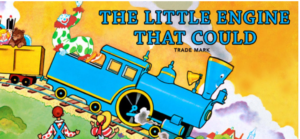
Last week the Durham Orange Rail project hit a series of setbacks which led GoTriangle Board spokesperson Sig Hutchinson to liken the rail project to a “broken puzzle”.
On Tuesday, the FTA told GoTriangle to increase their budget by $237 million.
The next day, Duke University and two rail road companies sent letters declining to sign cooperative agreements for the project.
Over the past few years, the DOLRT project could have been likened to “The Little Engine that Could”; however, it appears unlikely that DOLRT can overcome the many problems ahead and chug over the mountain. The inspirational story, “I think I can, I think I can” inspired us as children. But given the engineering problems, exorbident costs, we need to move on to transit that will serve more people. This approach needs to pull together all parts of our community.
WRAL news reported the story earlier this week, including a draft copy of the FTA consultant’s Risk Analysis.
We can gather from the draft Risk Assessment report that the cost news won’t be better in the coming weeks:
- To cover new costs associated with changes to downtown Durham and other risks, the FTA has asked GoTriangle to add $237 million to the budget;
- By law, an additional 10% contingency is required;
- The Downtown Durham tunnel solution is only at 20% engineering so costs could be even higher;
- Cost-cutting to one railroad car; transit station cuts with Woodmont and Hamilton Road in Chapel Hill at the top of the list and other items, such as reducing to single car trains and ending the route at Alston Avenue, on the list. (See Table 6, page 16)
In a second article, WRAL outlines the $130 million in costs incurred by the project thus far.
The GoTriangle Board of Trustees will hold a work session Wednesday to address these recent developments.
While many on the GoTriangle board have continued their strong support for the plan, an article by Geoff Durham, President of the Durham Chamber of Commerce, addresses in this article the rampantly rising costs of the DOLRT and urges elected leaders to make sure that the foundation of the community is on solid ground “for all taxpayers”.
In recent weeks, other problems have emerged, including:Inflation of revenue estimates for station areas, the fact that 70-80% of all new DOLRT riders will arrive at stations by vehicle and a memo showing that Chapel Hill Transit faces capital and operating shortfalls.
With the cost approaching $4 billion, we believe it is time for our elected representatives to think carefully about a future plan that drops the Durham Orange Light Rail portion of the transit plan and replaces it with more affordable transit for all.
